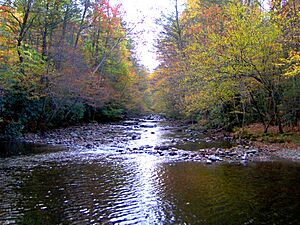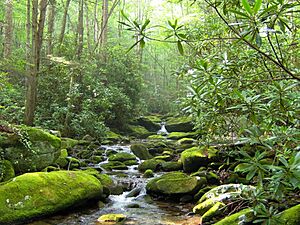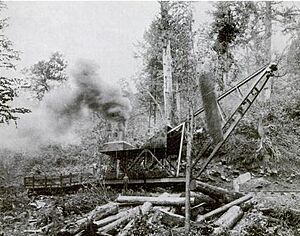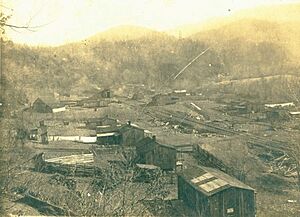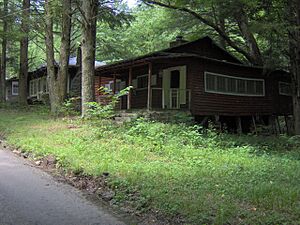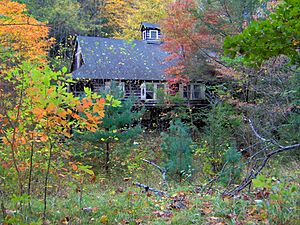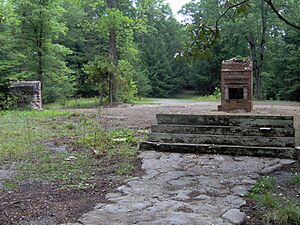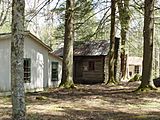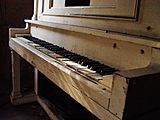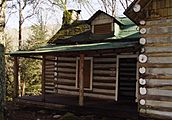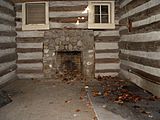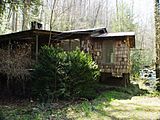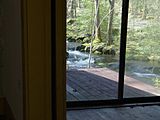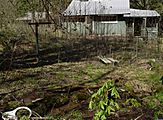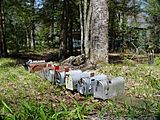Elkmont, Tennessee facts for kids
Quick facts for kids |
|
|
Elkmont Historic District, Great Smoky Mountains National Park
|
|
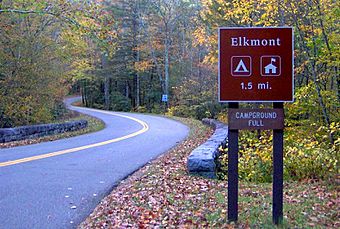
Elkmont, Tennessee
|
|
| Location | Off TN 73 SW of Gatlinburg |
|---|---|
| Nearest city | Gatlinburg, Tennessee |
| Architectural style | Late 19th And Early 20th Century American Movements, vacation cabins;hotel |
| NRHP reference No. | 94000166 |
| Added to NRHP | March 22, 1994 |
Elkmont is a special place in the Great Smoky Mountains of Tennessee. It's found in a valley along the Little River. Over time, Elkmont has been many things: a home for early settlers, a busy logging town, and a fun vacation spot.
Today, Elkmont is a large campground, a park ranger station, and a historic area. It is all looked after by the Great Smoky Mountains National Park.
In 1908, a company called Little River Lumber started the town of Elkmont. It was a base for their tree-cutting work. By 1910, people who loved hunting and fishing from Knoxville bought land there. They started a group called the "Appalachian Club." In 1912, a big hotel, the Wonderland Park Hotel, was built overlooking Elkmont.
Later, in 1919, another group of Knoxville business people bought the Wonderland Hotel. They started the "Wonderland Club." For the next 20 years, both clubs became fancy vacation spots. Wealthy people from East Tennessee would gather and socialize there.
When the national park was created in the 1930s, many cottage owners in Elkmont were allowed to stay for life. These agreements changed to 20-year leases in 1952 and were renewed in 1972. However, the National Park Service did not renew the leases in 1992. The plan was to remove the hotel and cottages.
But in 1994, the Wonderland Hotel and many cottages were listed on the National Register of Historic Places. This made them special and started a long debate about their future. In 2009, the National Park Service decided to restore the Appalachian Clubhouse and 18 cottages. These were older and more important. All other buildings, including the Wonderland Annex, were to be removed. The main hotel had already fallen down in 2005.
Contents
Exploring Elkmont's Landscape
Elkmont is in a narrow, flat valley. This valley was formed where the Little River and Jakes Creek meet. Tall mountains surround the valley. Meigs Mountain is to the west, Sugarland Mountain is to the east, and Cove Mountain is to the north. To the south are Blanket Mountain, and the slopes of Kuwohi and Mount Collins.
The Little River starts about five miles above Elkmont. It begins as a small stream on the slopes of Kuwohi. It gets bigger as it joins other streams. Just past Elkmont, the river turns west. It meets Middle Prong at a popular swimming spot called the "Y."
Elkmont has three main parts. The Wonderland Club section is on a hill in the northeast. This is where the Wonderland Hotel used to be. The Elkmont campground and ranger station are in the center. This area was once the Little River Lumber Company's logging town. The Appalachian Club section is mostly in the southern part of Elkmont. It is divided into "Daisy Town," "Society Hill," and "Millionaires' Row."
Elkmont's Past: A Journey Through Time
Early Settlers and Their Simple Lives
Long ago, Native Americans lived in the Elkmont area. The first European settlers arrived around the 1840s. Jacob Hauser was likely the first. Then came the family of David Ownby, who looked for gold. The small community was simply called "Little River."
Like many mountain communities, people here grew their own food. They grew corn and apples and kept bees for honey. Several gristmills (mills for grinding grain) were built along Jakes Creek.
Only two buildings from this early time still stand in Elkmont. These are the Avent cabin (built around 1850) and the Levi Trentham cabin (built around 1830). The Avent cabin was used as an art studio by artist Mayna Avent until 1940. The Levi Trentham cabin was moved in 1932 to be a guest house.
Lem Ownby, David Ownby's grandson, was born near Jakes Creek in 1889. He lived in a cabin he built with his father. When the national park was created, Lem was allowed to live there for his whole life. He sold honey to hikers for many years. Lem Ownby died in 1984.
The Logging Boom in Elkmont
In the 1880s, a businessman named John L. English started cutting trees along Jakes Creek. He built splash dams on Little River to float logs downstream. His business ended around 1900.
In 1901, Colonel Wilson B. Townsend bought a lot of land along Little River. He started the Little River Lumber Company. He built a sawmill in Tuckaleechee Cove, which became the town of Townsend. Instead of splash dams, Townsend built a logging railroad. This railroad moved logs from the mountains to the sawmill. Elkmont became a transfer station in 1908. Logs were moved from special mountain trains to regular trains here.
Early Elkmont was a simple logging camp. It had small houses, a post office, a hotel, and sheds for the railroad. Many loggers lived in boarding houses. As logging moved higher up the mountains, the company moved the houses too. They loaded them onto train cars! Elkmont stayed the main base for logging in the valley.
In 1926, Townsend sold most of his land to the Great Smoky Mountains Park Commission. The company stopped logging in 1939. Today, the park service has a campground where the logging town used to be. Not much is left from the logging days. Some resort cottages might have been old logging houses.
Elkmont Becomes a Resort Town
At first, Townsend let hunters and fishermen use his railroad to reach the forests. As the trees were cut down, Townsend started to advertise Elkmont as a mountain getaway. In 1909, the Little River Railroad offered a special train service from Knoxville to Elkmont.
In 1910, a group of wealthy Knoxville hunters and fishermen formed the Appalachian Club. They bought land and built the Appalachian Clubhouse. Soon, members built their own cottages. The club became a mountain retreat for Knoxville's rich families.
In 1911, Townsend gave Charles Carter land to build on. In 1912, Carter opened the Wonderland Hotel. It was a resort with 50 rooms and a big balcony. Since it was hard to join the Appalachian Club, other people from Knoxville bought the Wonderland Hotel in 1919. They formed the Wonderland Club. About 10 cottages were also built on the hill.
In 1925, the Little River Lumber Company finished logging in some areas. They wanted to move the train tracks. To avoid problems with cottage owners, Townsend moved the tracks secretly. People in Elkmont were very upset. Luckily, the old railroad paths were perfect for building roads. In 1926, a road was built connecting Townsend to both the Wonderland Club and Appalachian Club. A picnic area called Metcalf Bottoms was named after a family who helped the road workers.
The National Park Idea Starts in Elkmont
In 1920, Willis P. Davis and his wife Anne, who had a cottage in Elkmont, suggested creating a national park in the Smokies. This idea came after they visited Yellowstone. While the Davises only suggested it, another Elkmont cottage owner, David C. Chapman, took action. Business owners in Knoxville saw how a national park could help. They began asking the government to create one.
The U.S. government agreed to create the park if Tennessee and North Carolina bought the land. Knoxville started a big effort to convince the Tennessee government. In 1925, Chapman hosted lawmakers at Elkmont to promote the park idea. The next year, Colonel Townsend made the first big land sale.
Even though the park idea started in Elkmont, some people there were against it. An attorney named Jim Wright gathered people at Elkmont. They wanted a national forest instead of a national park. Wright also wanted to build many roads across the Smokies. Because of his efforts, the first law to buy land for the park did not include Elkmont. Cottage owners were allowed to sell their cottages for half price in exchange for lifetime leases.
Historic Buildings of Elkmont
Many Appalachian Club members agreed to change their lifetime leases to 20-year leases. This was to get better electricity and ensure the utility had customers. These leases were renewed in 1952 and 1972. But in 1992, environmental groups, especially the Sierra Club, stopped the renewals. The Wonderland Hotel and most cottages went back to the National Park Service.
The park's plan was to remove all buildings so nature could grow back. However, in 1994, the Wonderland Hotel and several cottages were listed on the National Register of Historic Places. This gave them special protection. A big debate began about what to do with these old buildings.
In 2005, the Wonderland Hotel collapsed. Parts of the hotel that were historically important were saved. Only the annex and a chimney were left. In May 2016, the annex had a bad fire. In 2009, the National Park Service announced plans to restore the Appalachian Clubhouse and 18 cabins. These were in the Appalachian Club section. The remaining buildings were carefully recorded and then removed in 2018. Many chimneys still stand.
Seventeen of the 19 buildings chosen for restoration are in the "Daisy Town" section of the Appalachian Club. They were chosen because they are the oldest and most important. These include the Appalachian Clubhouse (built in 1934), the Levi Trentham cabin (Elkmont's oldest building, from 1830), and the Addicks and Mayo cabins (thought to be old logging houses). There's also a children's playhouse called "Adamless Eden." Most cottages were built between 1910 and 1930. They are usually made of wood with board and batten siding. The Smith cabin and Levi Trentham cabin are log cabins.
The Byers cabin was also saved because it was linked to David Chapman, an early park supporter. The Spence cabin, a large lodge, has been restored. It is now used for day visits. All buildings in the Wonderland Club section will be removed. A sign will be placed where the Wonderland Hotel stood to tell its story.
Gallery




